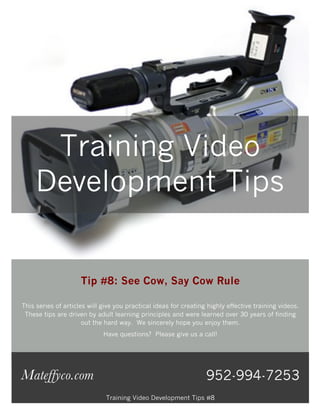
#8 Video Tips Article
- 1. Training Video Development Tips Tip #8: See Cow, Say Cow Rule This series of articles will give you practical ideas for creating highly effective training videos. These tips are driven by adult learning principles and were learned over 30 years of finding out the hard way. We sincerely hope you enjoy them. Have questions? Please give us a call! Mateffyco.com 952-994-7253 Training Video Development Tips #8
- 2. #8: See Cow, Say Cow Rule Among the wonderful aspects of developing training videos for clients are the unique settings in which we find ourselves. Sometimes it’s a restaurant at 3:00 a.m. filming a ham being sliced to the thickness of a piece of paper. Other times, it’s shooting under a car’s engine in a dealership’s service bay. In the video biz, there is always something new to learn and see. One of the more interesting shoots was for a video we created for an animal feed company. One of the subjects provides a vivid reminder of a hard and fast training video production rule, but back to that in a minute. The shoot was in a barn at the company’s research farm. The shot was of a researcher putting his gloved arm down a hole in the side of a cow. The goal of this procedure was to retrieve and examine whatever half-digested feed was churning way down inside the cow’s stomach. It was really cool in an “I’ve never seen that before” kind of way. Once I was assured this didn’t hurt the animal, I even got to try my hand at stealing dinner from her cowness. When we got into editing, the client wanted a few changes to the narration. The new scripting added a set of instructions for completing the same hand into stomach procedure for pigs. While the information was compelling, it violated the rule I mentioned. It’s called the Dissonance Rule. I use the See Cow, Say Cow Rule instead, because it’s more fun to say. Basically, it boils down to this: If you’re showing a cow, making sure you’re talking about a cow. You violate this rule when the narration doesn’t match the footage. It causes conflict in the brain by asking viewers to watch a set of images about one thing and simultaneously listen to narration about something else. When viewers try to figure out what to pay attention to, the images on the screen or the narrator’s words, it dramatically reduces the impact of the message. It also uses a lot of the learners’ mental calories, something they need for understanding and applying your teaching points. Here are some tips that will help your training videos pass the See Cow, Say Cow test: • Shoot the video scenes before recording the narration. It’s a lot easier (and cheaper) to change words rather than pictures. • If you use on-screen talent to describe the procedure or teaching points, make sure his/her words keep pace with what is happening in the video. They need to begin and end at the same time or darn close to it. • Have someone on set take detailed notes of any changes in your shot selections. That way, you can compare what you actually captured to what the script the narrator will use says and adjust as needed. • Be sure to keep unrelated items, procedures, or people out of your shots. Although they may not cause a great deal of viewer dissonance, they can be distracting. • Match the narration with the Character Generated Text (CG) you use to reinforce key points. So if you’re going to show a cow, talk about a cow. Don’t talk about a pig. Now don’t get me wrong, pigs are great. However, the human brain can only focus on one set of messages at a time. Ensuring that viewers don’t have to make a choice between what they see and what they hear will help you create highly effective training videos. Jack Mateffy is a nationally recognized speaker, author, video producer, and old wooden boat fanatic. Contact him at: mateffyco@frontiernet.net To learn more about Mateffy and Company’s training video production services and our Producing Excellent Videos Workshop please go to http://mateffyco.com/Avon.html Mateffy & Company 952-994-7253 mateffyco@frontiernet.net http://www.mateffyco.com Training Video Development Tips #8
